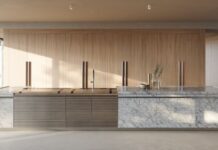Urban living: Flexible furnishings and micro-living in the comfort zone 2.0 looks at the market potential of furniture and interior design concepts for high-density living spaces.
“Urban living” is the dream for most people. For some, it means the promise of a better life; for others, it signifies individuality and independence. But living in urban areas is expensive. When living space becomes scarcer, living areas merge and furniture increasingly defines living zones, the choice of furnishings grows in importance.

As with any other resource, when living space becomes less widely available, it must be used more efficiently. Anyone who wants, or needs, to furnish a compact space has the choice between individual space-saving items of furniture and moving in to a space comprised of fully-fitted, but unalterable furniture. And that is precisely what the trendy micro-apartment is. Back in the 1920s, architect Margarete Schütte-Lihotzky realised that unifying space and furniture could represent the most ergonomic and economical way to furnish a home. This resulted in the triumph known as the “Frankfurt kitchen” – the mother of all fitted kitchens.
The current boom in micro-apartments in major cities suggests a renaissance in furnished housing. As such, it is not just new room concepts that are in demand, but also new design concepts for multifunctional and space-saving furniture.
 From a central European perspective, the prospect of a life in multifunctional living cells, like that of the fictional taxi driver Korben Dallas played by Bruce Willis in Luc Besson’s science fiction-thriller “The Fifth Element” (1997), is more of a nightmarish thought. But the micro-apartment is currently undergoing a process of reinterpretation – away from the image of the improvised student flat and becoming instead a comfortable living suite. With simple, functional furnishings for students who are always on the lookout for housing and in luxury versions for commuting executives and job hoppers, who never stay in one place for long.
From a central European perspective, the prospect of a life in multifunctional living cells, like that of the fictional taxi driver Korben Dallas played by Bruce Willis in Luc Besson’s science fiction-thriller “The Fifth Element” (1997), is more of a nightmarish thought. But the micro-apartment is currently undergoing a process of reinterpretation – away from the image of the improvised student flat and becoming instead a comfortable living suite. With simple, functional furnishings for students who are always on the lookout for housing and in luxury versions for commuting executives and job hoppers, who never stay in one place for long.
The flat-share is dead – long live the micro-apartment
Property companies and developers are just starting to discover this profitable business model. In Berlin (Alexander Tower, Studio B, The Fizz and so on), Cologne (Quartillion) or Amsterdam, flagship projects are currently emerging that range from inexpensive to luxury. When it comes to fitting out such apartments with multifunctional and versatile furniture, design elements such as fittings and lightweight components are essential. Furniture technology is becoming a key innovator in these new living environments in which the fittings define the furnishings. At least this is the perspective of the German fittings specialist Häfele, which introduced its Häfele Concept for flexible living and working in a small space at interzum 2017: a student apartment and a business apartment, consisting of industrially produced, modular furniture. This example shows how closely the furniture and construction industry will work together in individual areas in future.
 The study presented at imm cologne in 2017 by designer Michael Hilgers shows that options for micro-apartments do not need to be restricted to built-in systems or functional blocks. In an instant, “work-dress” converts from an apparently normal wardrobe into a comfortable, extendable workspace including rolling cabinets. The Berlin-based designer is known for his intelligent space-saving solutions. With a footprint of 0.9 square metres, his “Flatmate” design for furniture makers Müller Möbelwerkstätten is, for instance, the smallest fully equipped bureau on the market.
The study presented at imm cologne in 2017 by designer Michael Hilgers shows that options for micro-apartments do not need to be restricted to built-in systems or functional blocks. In an instant, “work-dress” converts from an apparently normal wardrobe into a comfortable, extendable workspace including rolling cabinets. The Berlin-based designer is known for his intelligent space-saving solutions. With a footprint of 0.9 square metres, his “Flatmate” design for furniture makers Müller Möbelwerkstätten is, for instance, the smallest fully equipped bureau on the market.
Yet the trend for micro-apartments had barely been announced – enabling “digital nomads” to withdraw to their collapsible hideaways, unburdened by unnecessary furniture and bothersome possessions, without having to think constantly about cleaning and rearranging things – when the trend was once more decried. If a recently published study from Ernst&Young is to be believed, members of Generation Y do not so much dream of the minimalist life of modern nomads as of domestic bliss in their own little houses.
City or country – (not just) a question of cash
However, this dream has a catch: because the ideal property should not only be located somewhere in the suburbs – with more space, a feeling of security, nature on the doorstep and, ideally, easy access to the city – it should also be affordable. Therefore, according to opinion pollsters, young families especially are again seeing opportunities even in the countryside. After all, affordable living space on the outskirts of cities is in short supply as well. New York, London and Paris led the trend, Berlin is diligently following suit and on the outskirts of Munich and Hamburg they have been building on what was once meadows for years.
These ever-thicker bands of urban sprawl offer younger, digitally networked, family-focused types an opportunity to choose the modest scale and good infrastructure of sparsely populated regions over the densification of space, cultural activities, noise and social networks. And so, the decision between town and country also to some extent becomes a choice between local community and online community. Always with the proviso that fibre optic broadband is available. In that case, nothing stands in the way of the country kitchen and XXL interiors.
Flexible, multifunctional, digital: the furniture of the future
For everyone else, the industry is currently hard at work developing mini-kitchens, which are vastly superior to the famous “Frankfurt kitchen” in terms of ergonomics and movable units. And yes, there’s even a cabinet-style sauna. The S1 sauna from Klafs, which took the market by storm in 2016, is now available in an even smaller XS version. With a width of just 142 cm, like a zoom lens, the depth of the sauna can be extended from 60 cm to 160 cm – in just 16 seconds.

Where in the past space-saving tricks, such as the foldaway bed or the rotating carousel for pans, were only to be found in children’s bedrooms and kitchens, the entire home is now being explored for as-yet untapped opportunities. Whether pull-out cabinets or collapsible dressing tables for the bathroom, comfortable foldaway beds or space-optimised wardrobes – no stone is being left unturned. In the process, mechanical movements are often being supported by motors and can thus be operated via apps or voice control. As a result, wall units can be opened automatically on demand, or hard-to-reach niches upgraded to space-saving miracles with one gesture.

With the digitisation trend, the subject of ergonomics is also brought further into the foreground for sofas: armrests can be folded here and backrests adjusted there to suit the sitter’s level of tiredness.
This means that even the narrowest hallway can become a home office, the smallest space a multifunctional living, dining and work room, an alcove a bedroom, high ceilings turned into storage-space marvels and large rooms into two-room apartments thanks to made-to-measure cupboards acting as room dividers. With smart-home technology and the corresponding controllable mechanisation of furniture, it’s not just large houses, but also small city apartments as well as unused office and commercial spaces that are evolving into comfort zones, version 2.0.
In a shrinking world, space-saving concepts are in great demand
Three-quarters of Germans already live in cities – a trend that is slowly on the rise. Individual cities, such as Leipzig and Frankfurt, are developing so dynamically that city planners can hardly keep up and complain about housing shortages. Having said that, with an urbanisation rate of about 75.5% (2016), Germany is still “only” mid-table in Europe (source: Statista). In France (79.5%), Spain (79.8%) and the UK (82.84%), the rate is much higher and from Scandinavia up to the Benelux countries, the proportion of the population living in cities rises to an incredible 97.9% (Belgium). Worldwide, North America has the highest rate of urbanisation (81%), while the majority of the inhabitants of Asia (46%) and Africa (40%) still live in rural areas – a potential future market for compact furniture concepts for urban living?

In any event, according to estimates by the United Nations, there will already be 43 megacities around the world by 2030, and over 70% of the world’s population will live in urban areas by 2050. And that’s not all: the world’s population is growing – the planet is not. Figures from the German Foundation for World Population (DSW/Deutsche Stiftung Weltbevölkerung) suggest that, even in Germany, approximately 83% of people will live in conurbations in 40 years’ time.
And so, there’s no avoiding the fact that living space per person is reducing, even if the average dwelling size has increased slightly thanks to growing housing concentration in the suburbs. More single people (young and old), more single parents and more and more families will need or want to manage in ever-smaller city dwellings. And not just students, but also single, higher-income earners like to live in central locations and enjoy the infrastructure for work, social networks, co-working spaces, restaurants, entertainment and culture.
The Scandinavian formula for success: more lifestyle in less space
As it happens, there has already been a clear trend towards smaller, stand-alone furniture in the past couple of years. Scandinavian furniture brands in particular are increasingly offering cocktail chairs instead of large lounge chairs, intimate two-seaters instead of XXL sofas and modestly sized desks on dainty feet. And it’s not just a question of aesthetics, because the pragmatism firmly anchored in Scandinavian design culture fits easily with the times. Perhaps this is another reason why their furniture and lifestyle concepts are so desirable at the moment. After all, they combine the essential with the enjoyable and give the necessity for reduction a comfortable, tolerable appearance.

The urbanisation trend, demographic change and the concurrent sweeping process of digitisation reinforce each other in terms of their influence on the culture of our home lives, which is likely to undergo lasting change in the coming decades. With diverse concepts and multifunctional products, space and furniture will be defined more closely as a single unit.
For more information visit imm-cologne.com
Article and images courtesy imm spotlight.




























